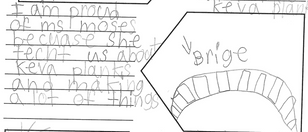


K-5th Grade Engineering
Music. Art. P.E. Library. A special entitled “Engineering” is unique on the elementary level. Engineering is a process of understanding, designing, and building informed by science and math. The skills that they learn and the stamina they build in my classroom are transferable to any profession they may choose in the future. This page is dedicated to sharing what I learn alongside my students.
Centering
Students' Ideas, Voices & Choices
"Language arts and literacy can be integrated smoothly into science and engineering education. These include reading and listening to read-alouds, writing explanations, and drawing models. Allow, encourage, and value multiple modes of sharing children's thinking (such as drawing, writing, and talking) and multiple forms of evidence." - Nancy Kober

Personal Reflections
(5-7 minute quick-writes)
My classroom is unique because of the consistent and frequent expectation for all students to handwrite personal reflections. (Handwriting is more brain-friendly than typing on a computer!) It is through engineering that we create innovators and problem solvers who will think about the world in ways we haven’t yet considered.
During the first week of the school, throughout the year, and at the end of the year, I give all of the K- 5th grade students an opportunity to reflect upon their experience with design challenges or express their interests in future challenges. Sentence stems are displayed on anchor charts (or pasted on the back of whiteboards) as a scaffold to help students express or expand upon their thoughts. (click on the images above to download a free copy)
I read each and every one of the 750+ responses. I quantify the results, scan the exemplar student papers, and use the data to plan future design challenges. During each 6-day rotation of classes, I anonymously share an exemplar interest survey or personal reflection to acknowledge the student-driven source of the design challenge. From water slides, to cars, to mazes, to suspension bridges, my instruction is relevant and culturally responsive. I am intentional about amplifying student voice and aligning their interests to the content standards. All students appreciate the opportunity to feel seen, heard, and valued. I get goosebumps reading their ideas for prototype improvements, peer collaborations, and personal growth (perseverance, fine motor skills, gross motor skills, fluency, pacing, time management, etc.).
Wall of Fame





The Engineering “Wall of Fame,” as the students affectionately call it, is a display posted outside of my classroom in a high-traffic hallway. During the design process, I circulate the classroom and take photographs of the students working collaboratively/independently testing or improving a prototype and when they are celebrating success. I voluntarily use my personal color ink printer to print 8x10 photos of the students and display the photos in plastic pockets. The photos hang alongside grade level exemplar written reflections of the corresponding engineering design challenge. The students’ reflections state what went well, what was a challenge, and what they would do differently next time. The action shots, written reflection, and public display are part of a transformative experience in which students learn something about themselves. I choose to consistently update this display every two weeks for all students to see themselves "doing engineering," give a sense of accomplishment, develop a STEM identity, and reinforce high expectations school-wide. This wall gains not only the attention of students passing by but also colleagues. Each new display sparks professional conversations and builds commUNITY.
"Sharing and comparing student-produced models allows peer to interact with and learn from each other's ideas. As children review each other's models, they realize there are different ways of interpreting or explaining the same phenomenon or problem." - Nancy Kober (p.102)


End-of-Year Reflection - 5th grade
"Love this showcase of amazing student engineers!" - Dr. Jacie Maslyk
"Wow! Fantastic area for a gallery walk. Kids must love seeing their work displayed." - Todd LaVogue

YouTube Playlists
View the 1-5 minute videos archived in my YouTube playlists. These playlists include testimonials of engineers and designers working in the field, engineering materials, design challenges, and my classroom examples. Students benefit from immediate, first-hand accounts of the journey to become an engineer, from a wide variety of people and peers who have a direct connection with it.
Tip: Turn on the closed-captioning (cc) or subtitles while students are watching. The transcription may not be completely accurate, but it does provide an excellent reading and fluency-building opportunity.
Beginning of the Year
Each year, I introduce myself as an educator and an author-illustrator to my K-5th grade students. I read aloud a few of my favorite pages in MY NAME IS AN ADDRESS. I show a 2-3 minute clip to introduce engineering and describe the purpose of my classroom. Then, I challenge students to express their name with a design challenge. Here are a few of the name-based design challenges! (Click on the images for more information and printables!)

Lesson Planning Resources
Recommended Reading
Celebration Gallery













































